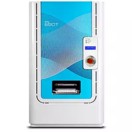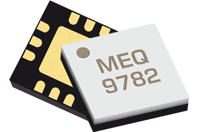Harvest & Collection
PRODUCTS
-
The VSX3716 is a conduction cooled 1.5 kW X-band solid state power amplifier optimized for pulse radars. X-band solid state power transmitters are efficient, high power, and compact with proven GaN transistor technology.
-
Reduce manual validation efforts, cut costs by up to 30%, get new products out the door faster, and enable seamless regulatory inspections.
-
Qorvo's QPA0812 is a packaged, high-performance power amplifier fabricated on Qorvo's production QPHT15 (0.15um) pHEMT process.
-
- Enables assay miniaturization in a broad range of applications
- Transfer from 384-well and 1536-well microplates
- Accurate, precise, contact-free acoustic transfer in volumes as low as 2.5 nL
- Transfer from Echo Qualified sample tubes* and microplates
* Available for tube-enabled models
-
The MEQ14-14ASM passive MMIC equalizer QFN is an ideal solution for compensating for low pass filtering effects in RF/microwave and high speed digital systems.
WHITE PAPERS AND CASE STUDIES
-
AEC System Proven Effective For Chloride Removal
In two bench-scale tests, a new technology effectively removed up to 99% of chlorides and 97% of total dissolved solids in a single pass. This solution offers a commercially viable alternative to traditional treatment methods.
-
Meet The Demand: Doubling Capacity At Two 503(b) Manufacturing Sites
503B compounders require special attention to maintain cGMP and regulation compliance. Examine the process for designing and managing new facilities for sterile and parenteral injectable manufacturing.
-
Safer And Faster Conjugation And Purification Of ADCs At 1-20 L Scale
Explore data demonstrating the successful engineering of a single-use tangential flow filtration system designed to meet the specific requirements of ADC processes.
-
Alerion Microbubble Cell Separation System Used For T Cell Negative Selection
Discover how the Alerion™ Microbubble Cell Separation System outperformed standard magnetic methods in T cell recovery, speed, and scalability — achieving higher cell quality with Akadeum’s innovative microbubble technology.
-
Tank Terminal Wastewater Treatment
In this case study, explore the results of Aquacycl's installation of a pilot-scale BETT system to treat a side-stream of wastewater from a tank terminal operator's facility.
-
Regulatory Affairs Project Manager
Discover how a ProPharma consultant effectively integrated tools, streamlined processes, and enhanced communications within a biotech company to ensure regulatory filings would be delivered promptly and with the highest level of quality.
-
Sole-Provider FSP Model Beats Schedule, Exceeds Expectations
See how this tight collaboration resulted in the swift acquisition of staffing at levels beyond initial expectations and propelled advancements in processes across a spectrum of workstreams.
-
High-Quality Performance Of Installation Activities And Quality Checks From Remote
Examine how LAPP overcame pandemic challenges with remote collaboration via OverIT's FSM Platform, reducing travel, saving time and money, and aligning with Sustainable Development Goals.
-
ProPharma Supports A Contract Manufacturer's Form 483 Response
Learn how a small contract manufacturer navigated a complex FDA 483 Observation notice and implemented effective remediation strategies that addressed multiple system-wide concerns.
-
Educating Globally Diverse Populations Through Branding & Visuals
See how this customized educational approach significantly enhanced recruitment and retention efforts, helping to ensure a more inclusive trial for Nonobstructive Hypertrophic Cardiomyopathy (nHCM).
-
How Digital Transformation In Sample Management Increases Efficiency
Explore a real-world example of how a dynamic and growing CDMO implemented a lab management system to improve efficiency and data integrity for their quality control sample management workflows.
-
Aegea Creates Brazil's Largest 3D Digital Sanitation Map As Part Of Their Intelligent Infrastructure Program
In this case study, learn about a highly interactive 3D map representing over 1,000 sanitation facilities in a virtual reality environment which optimizes performance, service availability, and reliability.
NEWS
-
Be Part of Photonics Future: CIOE 2025 Visitor Registration Live Now!4/9/2025
The 26th China International Optoelectronic Exposition (CIOE 2025) is set to take place from September 10–12, 2025, at the Shenzhen World Exhibition & Convention Center, spanning 240,000 square meters of exhibition space.
-
AEON Biopharma Appoints Industry Veteran Rob Bancroft As Chief Executive Officer4/21/2025
AEON Biopharma, Inc. (“AEON” or the “Company”) (NYSE: AEON), a clinical-stage biopharmaceutical company focused on developing a botulinum toxin complex for the treatment of multiple therapeutic indications, announced today the appointment of Rob Bancroft as President and Chief Executive Officer, effective April 29, 2025. Mr. Bancroft will also join AEON’s Board of Directors.
-
Motivosity Launches Lifestyle Spending Accounts To Help Companies Offer Flexible, Hassle-Free Employee Perks5/27/2025
Motivosity, the leading people-first employee recognition and rewards platform built for today’s workforce, is proud to announce the launch of its new Lifestyle Spending Accounts (LSAs) program.
-
Dielectric Partners With Foccus Digital For Brazilian Broadcast Growth8/15/2025
Dielectric’s Brazilian presence is about to radiate stronger through a new partnership with Foccus Digital that expand Dielectric’s broadcast business throughout the country.
-
Alvotech Signs U.S. Agreement To Expand Access For Newly Approved High-Concentration Interchangeable Biosimilar To Humira® (adalimumab)4/19/2024
Alvotech (NASDAQ: ALVO), a global biotech company specializing in the development and manufacture of biosimilar medicines for patients worldwide, announced today a long-term agreement with a strategic partner to further enhance access to Adalimumab-ryvk in the U.S. market, the newly U.S. Food and Drug Administration (FDA) approved high-concentration interchangeable biosimilar to Humira.
ABOUT
Harvest and Collection
Harvest and collection is the process used to retrieve biological agents and vaccines present in cell cultures or to harvest and collect stem cells from blood or bone marrow. Many bioresearch companies have sophisticated systems for harvesting and collecting cells. These systems make counting cells easier and they also protect against contamination.
Cells are harvested once the cells reach a density level in the cell culture medium that precludes further growth. The best time to harvest cells is when they are in a confluent state (at least 50% of the culture dish is covered and before 100% of the dish is covered).
Cells can be harvested using on of three methods: Mechanical, using Proteolytic enzymes, or using EDTA. Mechanical harvesting uses a rubber spatula to remove the cells from the growth surface or culture. This method is quick but can cause many cells to die because it is highly disruptive. This method is favored when harvesting lots of different samples of cells to prepare extracts.
In this case, viability of the cells doesn’t matter. Three enzymes; Trypsin, Collagenase, and Pronase can be used in combination with EDTA. The combination of these enzymes with the EDTA makes cells detach from the growth medium.
This method is easy but also has a downside. It can damage the cell surface by eating up exposed cell surface proteins. EDTA can be used alone to detach cells from their medium and it is gentler than using trypsin.
Normally, collected cells are placed in a new suspension, or growth medium to continue growing new cultures. This is referred to as passaging or splitting the cells.

















